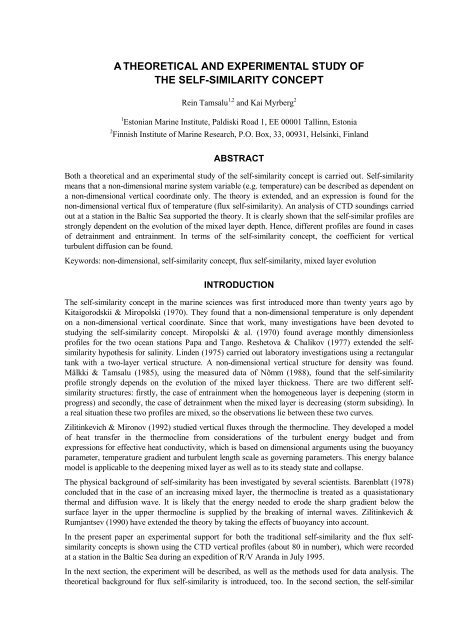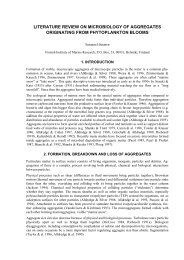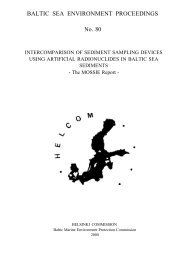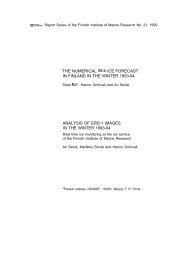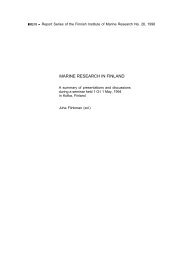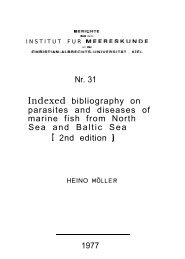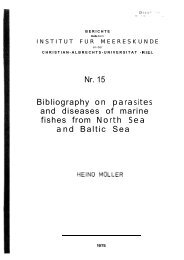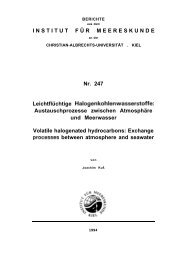a theoretical and experimental study of the self-similarity concept
a theoretical and experimental study of the self-similarity concept
a theoretical and experimental study of the self-similarity concept
You also want an ePaper? Increase the reach of your titles
YUMPU automatically turns print PDFs into web optimized ePapers that Google loves.
4Tamsalu & Myrberg MERI No. 37:3-13, 1998pr<strong>of</strong>iles will be shown <strong>and</strong> <strong>the</strong> results <strong>of</strong> <strong>the</strong> analyses <strong>of</strong> <strong>experimental</strong> data will be compared with <strong>the</strong>ory.In <strong>the</strong> last section, <strong>the</strong> main conclusions <strong>of</strong> <strong>the</strong> <strong>study</strong> will be given.The reader interested in <strong>self</strong>-<strong>similarity</strong> in more detail is referred to <strong>the</strong> papers <strong>of</strong> Barenblatt (1996) <strong>and</strong>Tamsalu & al. (1997).1. MATERIAL AND METHODS1.1 Theoretical derivation <strong>of</strong> <strong>the</strong> flux <strong>self</strong>-<strong>similarity</strong>The vertical structure <strong>of</strong> temperature in <strong>the</strong> seasonal <strong>the</strong>rmocline will be written in <strong>the</strong> following form:where:∂T∂q=− (1)∂t∂zT(z,t) is <strong>the</strong> temperature, q = w' T' is <strong>the</strong> temperature flux, t is time, z is <strong>the</strong> vertical coordinate directeddownwards. Substituting <strong>the</strong> non-dimensional coordinate:z−h()tς=H−h()tequation (1) can be written as follows:(2)∂Th T q( H−h) −( − ς)∂ ∂ ∂1 = −(3)∂t∂t∂ς ∂ςwhere:h(t) is <strong>the</strong> thickness <strong>of</strong> <strong>the</strong> upper mixed layer <strong>and</strong> H is <strong>the</strong> bottom <strong>of</strong> <strong>the</strong> seasonal <strong>the</strong>rmocline. The followingexpression for <strong>the</strong> non-dimensional temperature (θ) <strong>and</strong> for <strong>the</strong> non-dimensional temperature flux(Q) are proposed:T1() t −T(, t z)θ=T()t −1T H(4)Q q h() t − q (,=t z )q () t −qhHwhere:T 1 (t) is <strong>the</strong> temperature in <strong>the</strong> upper mixed layer, T H is <strong>the</strong> temperature at <strong>the</strong> bottom <strong>of</strong> <strong>the</strong> seasonal<strong>the</strong>rmocline (z=H), q h (t) is <strong>the</strong> temperature flux at <strong>the</strong> level z=h, q H is <strong>the</strong> temperature flux at <strong>the</strong> levelz=H. Here we suppose that q h (t) >> q H . Then (5) can be written as follows:(5)Q q h() t − q (,=t z )q () thUsing (4) <strong>and</strong> (5a), equation (3) takes <strong>the</strong> form:(5a)where:( 1−θ) 1 −( 1− ς)∂θ ∂Qaa2=∂ς ∂ς(6)
A <strong><strong>the</strong>oretical</strong> <strong>and</strong> <strong>experimental</strong> <strong>study</strong> <strong>of</strong> <strong>the</strong> <strong>self</strong>-<strong>similarity</strong> <strong>concept</strong> 5a1H−h∂T=q ∂th1; a2TH−T=qh1∂h∂tIf a 1 <strong>and</strong> a 2 are constants, <strong>the</strong>n θ <strong>and</strong> Q are functions <strong>of</strong> ς only. We start to investigate this problem fromequation (3). Vertically integrating (3) with respect to ς between <strong>the</strong> limits <strong>of</strong> 0 <strong>and</strong> 1, we get:where:1T = ∫Tdς0( H − ∂Thh) ( T T)t− − ∂∂t= q 1(7)∂hThe double integration, first between <strong>the</strong> limits <strong>of</strong> 0 <strong>and</strong> ς <strong>and</strong> <strong>the</strong>n between <strong>the</strong> limits <strong>of</strong> 0 <strong>and</strong> 1 gives<strong>the</strong> following results:where:~1 ςT= ∫dς∫Tdς0~∂T~ ∂h( H−h)−(2T− T1 ) = qh−q(8)∂t∂t0Using <strong>the</strong> relationship:<strong>and</strong> q = ∫qdς110~2T−T1=α 0(9)T −Twe get from (7) <strong>and</strong> (8) <strong>the</strong> following equation:a1where:T−T1κ=T −THα02 0 2− a2= − α−01 − α 1−α 1 − α β (10)10; β 0 = qq h0 0For <strong>the</strong> determination <strong>of</strong> q h we use <strong>the</strong> well-known relationship for entrainment (Phillips 1977) in <strong>the</strong>form:−1hqh =−c0( T −T1) ∂ ∂twhere:c 0 is a proportionality constant. Using (11) a 2 takes <strong>the</strong> form:(11)a2c0=− (12)κEquation (10) <strong>the</strong>n takes <strong>the</strong> form:a= ( 2− α ( 1+ c ) −2β )/( 1−α )(13)1 0 0 0 0
8Tamsalu & Myrberg MERI No. 37:3-13, 1998probably, some <strong>of</strong> <strong>the</strong>se were not "pure" type-B pr<strong>of</strong>iles, which is shown by <strong>the</strong> large scatter <strong>of</strong> <strong>the</strong> lattercurves. The 61 type-A curves (Fig. 2a) show a better fit with <strong>the</strong> <strong><strong>the</strong>oretical</strong> curve <strong>and</strong> less scattercompared to case B. This is clear, because <strong>the</strong> number <strong>of</strong> pr<strong>of</strong>iles is large <strong>and</strong> most <strong>of</strong> <strong>the</strong> time <strong>the</strong> mixedlayer evolution was <strong>of</strong> type-A.The above analysis <strong>of</strong> <strong>the</strong> results shows that <strong>the</strong> <strong>self</strong>-similar pr<strong>of</strong>ile (type A or B) <strong>of</strong> temperature is not soclearly visible instantaneously. Mälkki & Tamsalu (1985) pointed out that κ only reaches a constantvalue if an integration over <strong>the</strong> inertial period (about 14 hours) is carried out.The vertical flux <strong>of</strong> temperature wT ′ ′ has been calculated according to (14). The fluxes are presentedseparately for cases A <strong>and</strong> B as a function <strong>of</strong> ς . The most striking feature is that <strong>the</strong> shapes <strong>of</strong> <strong>the</strong> fluxpr<strong>of</strong>iles differ clearly from each o<strong>the</strong>r. In case A <strong>the</strong> flux has its maximum value near ς=0 <strong>and</strong>decreases towards ς=1 (Fig. 3a), while in case B (Fig. 3b), <strong>the</strong> maximum flux is reached betweenς= 02 . −03. , decreasing again towards ς=1.After deriving <strong>the</strong> vertical flux <strong>of</strong> temperature wT ′ ′ , a vertical integration <strong>of</strong> <strong>the</strong> <strong>experimental</strong>ly-derivedpr<strong>of</strong>iles is carried out. We investigate here only case A.The calculated values <strong>of</strong> α 0lie between 0.69-0.82, <strong>and</strong> we take α 0=0.75. The calculated β 0was 0.61,<strong>and</strong> we take β 0=0.6. The calculated values <strong>of</strong> κ lie between 0.72-0.77, <strong>and</strong> we take κ=0.75. This canalso be found by integrating (4) using (15):1T1() t −T()t∫ θς d == κT()t −01T HIntegrating (6) with respect to ς , we get:(17)ςς⎛ ⎞⎜ς−∫θdς⎟a1 −(( 1− ς) θ+∫ θdς) a2= Q(18)⎝ ⎠0Integrating (6) between <strong>the</strong> limits <strong>of</strong> 0 <strong>and</strong> 1, we get:0( 1−κ)a − κa = 1(19)1 2Substituting <strong>the</strong> values <strong>of</strong> α, β <strong>and</strong> κ into (12) <strong>and</strong> (13) we find, using (19), that c 0 =3.8,0 0a 1 =-11.2 <strong>and</strong> a 2 =-5.07 (20)Substituting (15) <strong>and</strong> (20) into (18) we get <strong>the</strong> following expression for <strong>the</strong> temperature flux Q:4Q = 1−( 1−ς )(21)The temperature flux can be written in <strong>the</strong> traditional way as follows:qT=−ν ∂ ∂z(22)
A <strong><strong>the</strong>oretical</strong> <strong>and</strong> <strong>experimental</strong> <strong>study</strong> <strong>of</strong> <strong>the</strong> <strong>self</strong>-<strong>similarity</strong> <strong>concept</strong> 9Fig. 2. The non-dimensional temperature θ plotted against <strong>the</strong> non-dimensional vertical coordinate ς .The curves based on observations are marked with dotted lines. The <strong><strong>the</strong>oretical</strong> curves are markedwith continuous lines: A -<strong>the</strong> mixed layer depth is increasing, B -<strong>the</strong> mixed layer depth is decreasing.
A <strong><strong>the</strong>oretical</strong> <strong>and</strong> <strong>experimental</strong> <strong>study</strong> <strong>of</strong> <strong>the</strong> <strong>self</strong>-<strong>similarity</strong> <strong>concept</strong> 11Using (15), (21) <strong>and</strong> (22) we get <strong>the</strong> following equation for <strong>the</strong> coefficient <strong>of</strong> vertical turbulent diffusionν:1 − ∂∂υ=− −ς= − −ς2 1 2 H h h( )∂01 h. *( H h) (∂1 )a tt2If <strong>the</strong> diurnal change in <strong>the</strong> upper mixed layer thickness is 1 m, <strong>and</strong> <strong>the</strong> <strong>the</strong>rmocline thickness is 30 m,<strong>the</strong>n:ν=0.3 cm 2 /sat <strong>the</strong> top <strong>of</strong> <strong>the</strong> <strong>the</strong>rmocline.For practical use, equations (23) <strong>and</strong> (9) are <strong>the</strong> most important ones.The non-dimensional vertical fluxes <strong>of</strong> temperature as a function <strong>of</strong> <strong>the</strong> non-dimensional vertical coordinateς are presented in Figure 4. The <strong><strong>the</strong>oretical</strong> curve corresponding to (21) is marked Q 2in caseA (Fig. 4a). The <strong>experimental</strong> non-dimensional vertical flux is marked as Q 1. The corresponding approximatecurves for detrainment (case B) are shown in Figure 4b. A comparison <strong>of</strong> <strong>the</strong> <strong>experimental</strong>results with <strong>the</strong>ory has <strong>the</strong> same main features as in <strong>the</strong> case <strong>of</strong> <strong>the</strong> traditional <strong>self</strong>-<strong>similarity</strong> <strong>concept</strong>. Incase A, <strong>the</strong> observations fit well with <strong>the</strong>ory.3. DISCUSSION AND CONCLUSIONSThe traditional <strong>self</strong>-<strong>similarity</strong> <strong>concept</strong> as well as <strong>the</strong> extended <strong>the</strong>ory <strong>of</strong> <strong>self</strong>-<strong>similarity</strong> <strong>of</strong> vertical fluxeswere compared with calculations based on an analysis <strong>of</strong> observations. In general, <strong>the</strong> observationssupported <strong>the</strong> <strong>the</strong>ory. However, <strong>the</strong> four-day expedition was far too short to ga<strong>the</strong>r an adequate data set<strong>of</strong> CTD pr<strong>of</strong>iles in different stability conditions <strong>of</strong> <strong>the</strong> air-sea interface with respect to <strong>the</strong> evolution <strong>of</strong> <strong>the</strong>mixed layer thickness.The <strong>self</strong>-similar pr<strong>of</strong>iles for temperature based on <strong>the</strong> observations showed that different kinds <strong>of</strong> pr<strong>of</strong>ilesexist depending on <strong>the</strong> evolution <strong>of</strong> <strong>the</strong> mixed layer, with different pr<strong>of</strong>iles being found for cases <strong>of</strong>entrainment (case A) <strong>and</strong> detrainment (case B). The observational pro<strong>of</strong> for <strong>the</strong> <strong>self</strong>-similar structure <strong>of</strong>temperature was better in case A, while <strong>the</strong> pr<strong>of</strong>iles representing case B gave less satisfactory evidence.This is partly because <strong>of</strong> <strong>the</strong> small number <strong>of</strong> case-B pr<strong>of</strong>iles measured. On <strong>the</strong> o<strong>the</strong>r h<strong>and</strong>, most <strong>of</strong> <strong>the</strong>time case A conditions dominated, <strong>and</strong> pr<strong>of</strong>iles representing case B were not always pure; i.e. somepr<strong>of</strong>iles represented <strong>the</strong> transition between detrainment <strong>and</strong> entrainment. However, <strong>self</strong>-<strong>similarity</strong> <strong>of</strong>temperature becomes visible if a time-integration over an inertial period (about 14 h ) is carried out (seeMälkki & Tamsalu 1985).The pr<strong>of</strong>iles <strong>of</strong> <strong>the</strong> vertical temperature fluxes showed a clear difference between cases A <strong>and</strong> B. Thenon-dimensional fluxes <strong>of</strong> temperature also showed differences in <strong>the</strong> pr<strong>of</strong>iles based on <strong>the</strong> evolution <strong>of</strong><strong>the</strong> mixed layer depth. In case A, <strong>the</strong> fit <strong>of</strong> <strong>the</strong>ory with observations was better than in case B, <strong>the</strong>reasoning for this being <strong>the</strong> same as in <strong>the</strong> case <strong>of</strong> <strong>the</strong> <strong>self</strong>-<strong>similarity</strong> pr<strong>of</strong>ile for temperature.In <strong>the</strong> case <strong>of</strong> an entrainment type <strong>of</strong> pr<strong>of</strong>ile, <strong>the</strong> coefficient <strong>of</strong> vertical turbulent diffusion can be solvedin <strong>the</strong> stratified layer using <strong>the</strong> flux-<strong>self</strong>-<strong>similarity</strong> <strong>concept</strong>. Thus, <strong>the</strong> <strong>self</strong>-<strong>similarity</strong> <strong>concept</strong> can be usedas a tool to parameterize <strong>the</strong> vertical turbulence in numerical modelling.2(23)
12Tamsalu & Myrberg MERI No. 37:3-13, 1998Fig. 4. The non-dimensional vertical flux <strong>of</strong> temperature Q plotted against <strong>the</strong> non-dimensional verticalcoordinate ς . Curve Q 1 is based on <strong>experimental</strong> results, while curve Q 2 is based on <strong><strong>the</strong>oretical</strong> calculations:A -<strong>the</strong> mixed layer depth is increasing, B -<strong>the</strong> mixed layer depth is decreasing.
A <strong><strong>the</strong>oretical</strong> <strong>and</strong> <strong>experimental</strong> <strong>study</strong> <strong>of</strong> <strong>the</strong> <strong>self</strong>-<strong>similarity</strong> <strong>concept</strong> 13REFERENCESBarenblatt, G. 1978: Self-<strong>similarity</strong> <strong>of</strong> temperature <strong>and</strong> salinity distributions in <strong>the</strong> upper <strong>the</strong>rmocline.- Izv., Atmospheric <strong>and</strong> Oceanic Physics, No. 11, 820-823 (English edition).Barenblatt, G. 1996: Scaling, <strong>self</strong>-<strong>similarity</strong>, <strong>and</strong> intermediate asymptotics. - Cambridge texts in appliedma<strong>the</strong>matics, Cambridge University Press, U.K., 386 pp.Kitaigorodskii, S. & Miropolski, Y. 1970: On <strong>the</strong> <strong>the</strong>ory <strong>of</strong> <strong>the</strong> open-ocean active layer. - Izv., Atmospheric<strong>and</strong> Oceanic Physics, 6, No. 2, 178-188 (English edition).Linden, P. 1975: The deepening <strong>of</strong> a mixed layer in a stratified fluid. - J. Fluid. Mech., 71, part 2, 385-405.Miropolski, Y., Filyushkin, B. & Chernyskov, P. 1970: On <strong>the</strong> parametric description <strong>of</strong> temperaturepr<strong>of</strong>iles in <strong>the</strong> active ocean layer. - Oceanology, 10, No. 6, 892-897 (English edition).Mälkki, P. & Tamsalu, R. 1985: Physical features <strong>of</strong> <strong>the</strong> Baltic Sea. - Finnish Mar. Res. No. 252,110 pp., Helsinki.Nõmm, A. 1988: The investigation <strong>and</strong> simulation <strong>of</strong> <strong>the</strong> <strong>the</strong>rmohaline structure in <strong>the</strong> open part <strong>of</strong> <strong>the</strong>Gulf <strong>of</strong> Finl<strong>and</strong>. - PhD-<strong>the</strong>sis, Leningrad Hydrometeorological Institute, 242 pp. (in Russian).Osborn, T. & Cox, C. 1972: Oceanic fine structure. - Geophys. Fluid Dyn., 3, No. 5, 265-354.Phillips, O. 1977: Entrainment. - In: modelling <strong>and</strong> prediction <strong>of</strong> <strong>the</strong> upper layers <strong>of</strong> <strong>the</strong> Ocean (Kraus,E.B.) Pergamon Press, Oxford, pp. 92-101.Reshetova, O. & Chalikov, D. 1977: Universal structure <strong>of</strong> <strong>the</strong> active layer in <strong>the</strong> ocean.- Oceanology, 17, No. 5, 509-511 (English edition).Tamsalu, R., Mälkki, P. & Myrberg, K. 1997: Self-<strong>similarity</strong> <strong>concept</strong> in marine system modelling.- Geophysica, 33(2): 51-68.Zilitinkevich, S.S. & Rumjantsev, V. 1990: A parameterized model <strong>of</strong> <strong>the</strong> seasonal temperature changesin lakes. - Environmental S<strong>of</strong>tware, Vol. 5, No. 1, 12-25.Zilitinkevich, S.S. & Mironov, D. 1992: Theoretical model <strong>of</strong> <strong>the</strong> <strong>the</strong>rmocline in a freshwater basin.- J. Phys. Oceanogr., Vol. 22, No. 9, 988-994.


